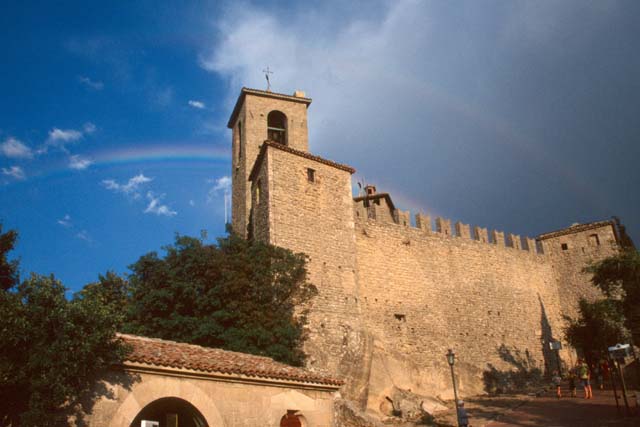|
||||||
|
History
As far as anyone can make out, the tiny republic's history is a melange of truth, semi-fiction, interpretation and outlandish fantasy. Although traces of prehistoric humans have been found, the history of San Marino only really kicks off with the appearance of the republic's namesake, Saint (San) Marino.
Rumour and popular account has it that some time back in the middle of the third century, or early fourth century, Diocleziano ordered the reconstruction of the walls of nearby town Rimini, which were destroyed by Demonstene, the king of Liburni. |
|
|
Among the many stonecutters bought from Europe to complete the project were two remarkably devout men, Marino and Leo. This was a time in Christianity's history when holy men were plentiful on the both the ground and the gibbet: extreme forms of persecution went hand-in-glove with extreme forms of religious behavior as holy men abnegated, flagellated and fasted in Gothic proportions, all to serve the greater glory of God.
Marino and Leo were the apostles of their time and dedicated their lives to the usual litany of saintly behavior - extreme self-denial, florid acts of sacrifice, performing miracles of the making-cripples-walk-and-blind-see type - right up until they went their separate hermetic ways (Leo to Montefeltro and Marino to Mount Titano). They quickly gathered a band of followers together, and by the 12th century San Marino had evolved into an independent commune ruled by its own statutes and consuls, and protected from the meddling of bishops and the incursions of neighboring armies by isolation and impregnable rock.
By the middle of the 15th century it was a republic ruled by a Grand Council - 60 men taken from the Arengo, or assembly of families. It's a system of government that survives today. Serious attempts at annexing the maverick republic were made in the 16th century - Cesare Borgia even got as far as a temporary occupation - but San Marino survived the Renaissance as a republic, albeit by its fingertips, as a relic of the self-governing Italian city-states.
Ironically enough it was Napoleon's wholesale invasion of Italy that restored San Marino to full strength as an independent republic. Whether by dint of political expediency, or because he truly admired the independent-minded San Marinese, or (as some have suggested) because he was amused by San Marino - in the same way that Mr Atlases are tolerantly amused by sand-kicked-in-their-face weaklings who vainly punch above their weight - the Little General offered to extend San Marino's territory. A terrified emissary was sent to kindly decline the Emperor's offer, the Grand Council wisely deciding that to sup with the devil you need a very long spoon. At the end of the Napoleonic Wars, the Congress of Vienna recognised San Marino's independent status, and it was as an independent country that it offered refuge to the fleeing nationalist, Garibaldi, in 1849. Garibaldi returned from exile in the United States some fifteen years later to lead the Italian population to unification.
At the end of the 1940s, despite its fondness for medieval manners, the republic momentarily capitulated to communism in the unlikely form of a Romanian businessman with a penchant for alliteration and Trotskyisms. Maximo Maxim's (or Max to the Max to his friends) motives became a little clearer when he championed a casino ('Markers for Marxism' perhaps?)and, unhampered by state taxes, drained the lira out of other national casinos and into the San Marino coffers. The flirtation with communism produced some ideological tension in the town, although the San Marinese commitment to Marxism was always more of an 'acqua de rosa' politics - a rose-water kind of Marxism - and as quietly as it had slipped into Communism it slipped back again into full independence 12 years later. Today it remains a proudly independent republic. |
|

